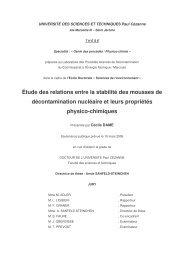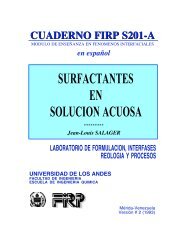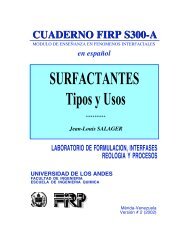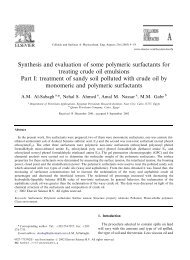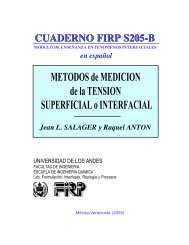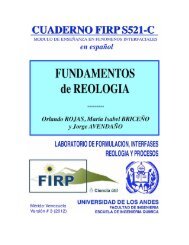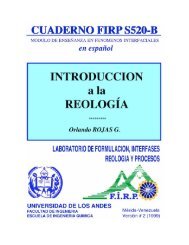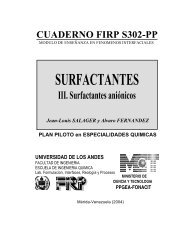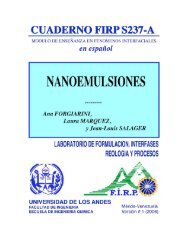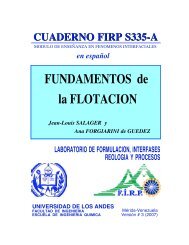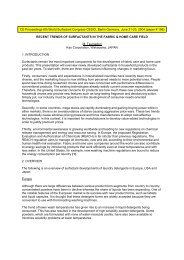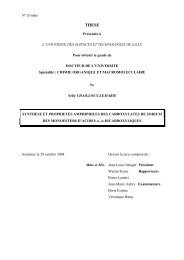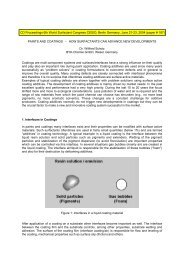Solubilization-emulsification mechanisms of detergency
Solubilization-emulsification mechanisms of detergency
Solubilization-emulsification mechanisms of detergency
Create successful ePaper yourself
Turn your PDF publications into a flip-book with our unique Google optimized e-Paper software.
C.A. Miller and K.H. Raney/Colloids Surfaces A: Physicochem. Eng. Aspects 74 (1993) 169-215 175<br />
for longer ethylene oxide and shorter<br />
hydrocarbon chains. Shifting the point <strong>of</strong><br />
attachment <strong>of</strong> the ethylene oxide chain from the<br />
end to the central portion <strong>of</strong> the hydrocarbon<br />
chain depresses the cloud point. The addition <strong>of</strong><br />
many common salts, e.g. sodium and potassium<br />
chlorides and sulfates, lowers the cloud point<br />
although the effects are much smaller than for<br />
ionic surfactants. However, some salts cause the<br />
cloud point to increase. The former effect is<br />
generally considered to stem from reduced<br />
hydration <strong>of</strong> the ethylene oxide chains resulting<br />
from competition with the added ions for the<br />
available water molecules. The latter effect<br />
occurs for ions such as I - , SCN - and most<br />
multivalent cations Which break the structure <strong>of</strong><br />
water. For some salts the anion and cation have<br />
opposite effects, with the stronger determining<br />
the direction <strong>of</strong> the cloud point shift. These<br />
effects have been recently discussed by Mackay<br />
[29].<br />
Other additives also influence the cloud point<br />
and other phase boundaries in non-ionic<br />
surfactant-water systems. Long-chain alcohols<br />
make the system less hydrophilic, as Fig. 5<br />
shows for the case <strong>of</strong> n-dodecanol added to<br />
mixtures <strong>of</strong> C 12E 5 and water [30].<br />
Fig. 5. Phase behavior resulting from the addition <strong>of</strong><br />
small amounts <strong>of</strong> n-dodecanol to I Wt'% C 12E 5 in<br />
water [30]; 30 denotes a three-phase region.<br />
Reprinted with permission from Academic Press.<br />
In this case, the cloud point is lowered by some<br />
23ºC when the alcohol content is only 10 wt.%<br />
relative to the surfactant. The temperatures for<br />
the other phase transitions are lowered as well.<br />
For the binary surfactant-water system, the<br />
phase rule constrains the three-phase regions,<br />
e.g. W + L 1 + Lα, to a single temperature, but<br />
the addition <strong>of</strong> the alcohol provides an<br />
additional degree <strong>of</strong> freedom and allows these<br />
regions to span a finite temperature range, as<br />
Fig. 5 indicates.<br />
The additive can, <strong>of</strong> course, be another<br />
surfactant. It is well known that the addition <strong>of</strong><br />
an ionic surfactant greatly increases the cloud<br />
point <strong>of</strong> an ethoxylated alcohol by adding an<br />
electrical repulsion between micelles and<br />
thereby inhibiting coacervation [31]. The<br />
opposite occurs when a second but more<br />
lipophilic non-ionic surfactant is added, e.g.<br />
C 12E 3 to C 12E 6, as shown in Fig. 6 [32]. This<br />
system is particularly interesting because, as<br />
noted previously, the Lα and L 3 phases do not<br />
occur in dilute mixtures <strong>of</strong> water and pure C 12E 6.<br />
However, both these phases appear when only a<br />
few per cent <strong>of</strong> the more lipophilic surfactant<br />
has been added, due to some rather complex<br />
Fig. 6. Phase behavior <strong>of</strong> mixtures <strong>of</strong> C 12E 6 and<br />
C1 2E 3 in water. The total surfactant concentration is<br />
fixed at 1.0 wt.% [32].



